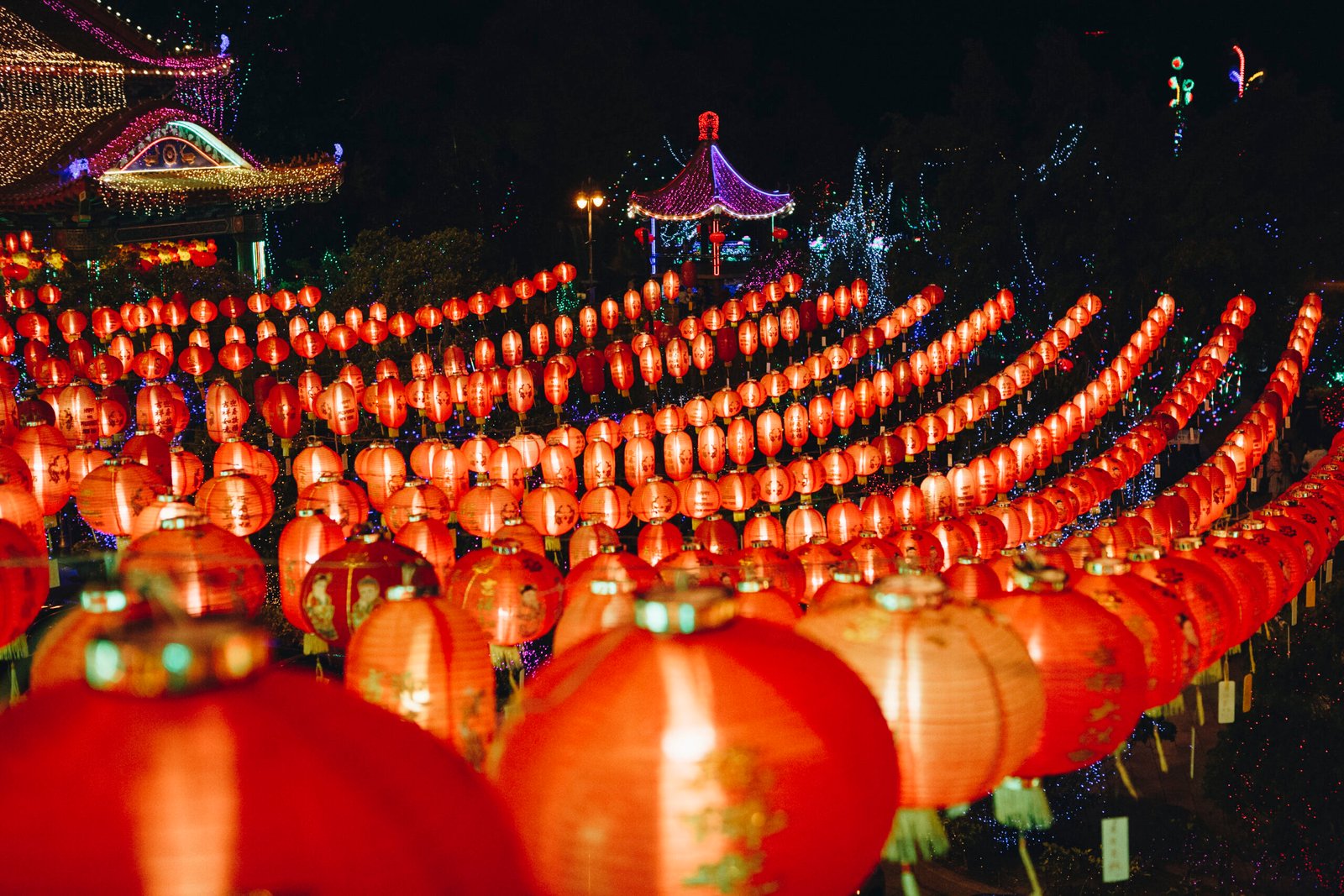One of the ancient activities on the 15th day of the first month of the year, by the lunar calendar, is the Lantern Festival. This falls in February or early March according to the Gregorian calendar. The Lantern Festival marks the end of New Year celebrations that go on for 15 days, starting from the Day of the Lunar New Year.
The time when many families that were separated for a long period get reunited is marked by the lighting of lanterns, trying to guess riddles, and tasting traditional foods. On the other hand, this is a time when colored lanterns light up in thousands as a symbolic gesture to let go of all troubles from the past year and start anew—with light and delight. It falls under the first full moon of the lunar calendar and hence carries themes of light, fortune, and family reunion.
The Historical Significance of the Lantern Festival
The Lantern Festival has been there for more than 2,000 years, and its historical origin conventionally is attached to numerous ancient Chinese perspectives such as Buddhism, Taoism, and imperial custom.
Buddhist Influence
- Among these widely accepted theories about its origin, there is one relating to Emperor Ming of the Eastern Han Dynasty: Having taken up Buddhism as a state religion, Emperor Ming ordered his subjects to light lanterns on the 15th day of the first month every year in homage to Buddha. He ordered the lighting of lanterns at the palaces and temples, and soon it became one of the most liked traditions in China. In the first place, this religious habit involved lighting lanterns in temples to symbolise the wisdom and enlightenment of Buddha; it became one of the most significant festivals among people.
Taoist Beliefs
- People also worship ‘Tianguan’ during the Lantern Festival, believed to be the God of Heaven or God of Good Fortune according to Taoism. It is believed that he blesses the people; therefore, lanterns are lightened, sacrifices are offered, praying for his blessing in different matters of their lives, such as good fortunes, health and prosperity, while Lantern Festival falls on the birthday of Tianguan. All this gives the celebration a more spiritual and religious colour.
Imperial Celebrations
- It finally emerged as a public activity in the form of magnificent celebrations in the imperial courts during the time of the Sui and Tang dynasties. The Tang Dynasty is specially and highly regarded as a time of cultural and artistic renaissance, while the emperors loved holding such huge lantern displays in concert with fireworks and different varieties of entertainment: music, dance, and poetry. Such public views of the lanterns were one way to manifest the wealth, power, and cultural refinement of an imperial family.
Lanterns Bear Cultural Meaning
At the core of the festival, lanterns have an immensely rich symbolic meaning. According to the beliefs of ancient Chinese, lighting those light sources was meant to ward off evil spirits and bad luck. Lanterns light the way for ancestors’ spirits.
Light and Hope: Lamps are the harbinger of light after the long, dark winter. They thus signify hope, warmth, and renovation. Since this festival falls during the spring season, the lanterns signify the start of the new agricultural year.
It has become an exquisite craftsmanship over time. Lanterns are of all shapes and sizes-from simple, plain red traditional lanterns to their more sophisticated versions in the form of animals, flowers, and mythological creatures. Most of them are even illuminated with light-emitting diode lights and powered by solar energy today, somehow joining this ancient
tradition with modern technology.
Lantern Riddles Traditions
Another interesting activity that developed along with the Lantern Festival started during the Song Dynasty between 960 to 1279 CE: solving lantern riddles. Various kinds of riddles would be proposed in writing or attached to the lantern for solution by all people. These range from intellectual stimulation to fun, often including wordplay, cultural references, and historical anecdotes.
The educative attribute of the riddles during the festivals allow the people to learn- particularly for the children- while rejoicing in the occasion. Normally, those who get the correct answer among the various riddles are usually given small gifts that oftentimes involve sweets or some symbolic prizes. This enhances camaraderie because people will really be gathering together to test their wits and enjoy the festive atmosphere.
Significance of Tangyuan during the Festival
Tangyuan is a kind of traditional glutinous rice ball in a round shape, sweet to taste, and filled with black sesame, red bean paste, peanuts, or even chocolate. More importantly, it carries symbolic meanings for wholeness and unity, as these round treats mean the unity of a family in harmony by eating them, so it enhances the theme of reunion and being close to loved ones.
The tangyuan are sweet and sour in a way that makes them enjoyable in the feasts. In fact, having the tangyuan during the festival is one of the ways through which families bind together and share in joy, showing their hopes for the future.
How the Festival Has Evolved Over Time
The Lantern Festival has hugely evolved from its ancient roots into the modern-day form. Here is how the festival has transformed over time:
- Ancient Times: It was first performed as a religious Lantern Festival-where lanterns are lit, sacrifice to the gods is performed, and people pray for prosperity ahead. These were generally confined to the rich and the imperial courts.
- Medieval: Starting with the Tang and Song dynasties, it took on more of a mass-based character: large public displays of lanterns, performances in forms such as the dragon and lion dances which have continued up to the present time.
- Times Changed: Today, the Lantern Festival has attained an international outlook. The lanterns displayed are huge and so much more beautiful, and cities also make provisions for high-tech light displays, drone shows, and fireworks. With growing ecological awareness, usages such as recycling materials in lanterns and reducing the quantity of fireworks have come into being. This is indeed proof that once again, Chinese culture is innovative and creative without losing the core of tradition.
Full Moon Symbolism
The completeness, reunion, and unity in the family -all these are taken as the chief symbols of the Lantern Festival, much like the full moon. A full moon, according to Chinese culture, signifies reunion and harmony in the family since it happens to shine brightly on this night to signify a circle of life and love which does not have any breaks. It was supposed to lighten the paths for people far away from their home to return and reunite with their dear ones.
As the Lantern Festival ushers in the first full moon of the year, it is a very special reunion date. And no matter how far away and busy people are, family is superior over everything else on this day.
Lantern Festival Celebrations in Modern Times
Lantern Festival has gone international in modern times, with celebrations conducted in countries that have a large Chinese population. Cities like Beijing, Hong Kong, Taipei, and Singapore hold spectacular lantern displays that integrate classic designs with innovative technology. The use of LED and solar-powered lanterns attests to the promise of sustainability, while interactive elements in some exhibitions include a virtual reality experience and augmented reality games.
The more modern activities include parades, dragon and lion dancing, folksy activities, and fireworks. Indeed, these performances have attracted both locals and tourists alike, catapulting the Lantern Festival into one of the most celebrated showcases of Chinese culture and folklore to the world.
Conclusion: The Timeless Appeal of the Lantern Festival
The Chinese Lantern Festival is still a bright and joyous event that has survived generation after generation. The Chinese Lantern Festival bridges the gap between the past and the present through common traditions of the people, reunions of families, and shared joyful people. Light, unity, and hope are things that unite the festivals together, standing at a universal level, making the festival borderless, cross-cultural.
It is constantly updated with newer technologies and global influences, yet remains a time of core values such as family togetherness, spiritual meaning, and pride in culture. The Lantern Festival carries on, from the dazzling glow of lanterns down to the sweet taste of tangyuan, in calling forth renewal and reunion within the hearts of the people throughout the country and world.






